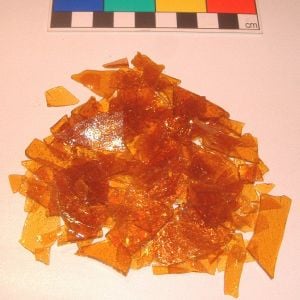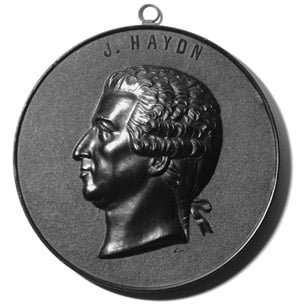Shellac
Shellac is the refined form of a natural, resinous, organic secretion of the tiny lac insect and that is used commercially as a wood sealer and finisher, floor polish, protective candy coating, and so forth. Lac is the name given to the actual secretion of the insect, and shellac technically is the refined lac in flake form (Bryk ***). However, the term also is used for refined lac that is suspended in an alcohol-based solvent, such as the thin varnish used to finish wood (Bryk ****).
commercial resin marketed in the form of amber flakes, made from lac[1], the secretion of the familiy of lac-producing insects, though most commonly from the cultivated Kerria lacca [2], found in the forests of Assam and Thailand.
Origin
Once it was commonly believed that shellac was a resin obtained from the wings of an insect (order Hemiptera) found in India. In actuality, shellac is obtained from the secretion of the female insect, harvested from the bark of the trees where she deposits it to provide a sticky hold on the trunk. There is a risk that the harvesting process can scoop the insect up along with the secretion, leading to its death. The natural coloration of lac residue is greatly influenced by the sap consumed by the lac insect and the season of the harvest. Generally in the trade of seedlac there are two distinct colors: the orange Bysacki and the blonde Kushmi.
When purified, the chemical takes the form of golden yellow/ golden brown flakes, this possibly providing the basis for the "Wing Source Story." Shellac is a natural polymer and is chemically similar to synthetic polymers, thus it is considered a natural plastic. It can be turned into a moulding compound when mixed with woodflour and moulded under heat and pressure methods, so it is classified as thermoplastic. But old mouldings tend to become thermoset, that is, they suffer chemical reactions over time and are no longer fusible.
Properties
Shellac is soluble in alkaline solutions such as ammonia, sodium borate, sodium carbonate, and sodium hydroxide, and also in various organic solvents. When dissolved in alcohol, typically blends containing ethanol and methanol, shellac yields a coating of superior durability and hardness and is available in numerous grades. It is used in the traditional "French polish" method of finishing furniture, and fine viols and guitars. Shellac is also used as a finish for certain former Soviet Bloc small arms' wood stocks, such as the stock of the AK-47. Shellac refined for industrial purposes either retains its natural wax content or is refined wax-free by filtration. Orange shellac is bleached with sodium hypochlorite solution to form white shellac and also is produced in wax-containing and wax-free form. Because it is compatible with most other finishes, shellac is also used as a barrier or primer coat on wood to prevent the bleeding of resin or pigments into the final finish, or to prevent wood stain from blotching. Lightly tinted shellac preparations are also sold as paint primer. Shellac is best suited to this application because, although its durability against abrasives and many common solvents is not very good, it provides an excellent barrier against water vapor penetration. Shellac based primers are thus an effective sealant to control odors associated with fire damage.
Products
Shellac was used from mid-19th century to produce small moulded goods like picture frames, boxes, toilet articles, jewellery, inkwells and even dental plates. Until the advent of Vinyl in 1938, phonograph records were pressed from shellac compounds. This use was common until the 1950s, and continued into the 1970s in some non-Western countries. Sheets of Braille were coated with shellac to help protect them from wear due to being read by hand. Shellac is used as a binder in Indian ink.
Shellac is edible and it is used as a glazing agent on pills and candies. Because of its alkaline properties, shellac-coated pills may be used for a timed enteric or colonic release.[3] It is also used to replace the natural wax of the apple, which is removed during the cleaning process.[4] When used for this purpose, it has the food additive E number E904. This coating may not be considered as vegetarian as it may, and probably does, contain crushed insects. In the tablet manufacture trade, it is sometimes referred to as "beetlejuice" for this reason. In some cases, shellac is known to cause allergies on contact, resulting in skin irritations.[5]
Although advancement in plastics have rendered shellac obsolete as a moulding compound, it remains popular for a number of other uses. In dental technology, it is still occasionally used in the production of custom impression trays and (partial) denture production. It is used by many cyclists as a protective and decorative coating for their handlebar tape.[6] Shellac is used as a hard-drying adhesive for tubular cycle tyres, particularly for track racing[7][8] Orange shellac is also the preferred adhesive for reattaching ink sacs when restoring vintage fountain pens.[9]
For some applications a corn protein called zein is a competitive substitute.
See also
- Bakelite
- Pharmaceutical glaze
ReferencesISBN links support NWE through referral fees
- ↑ Britannica Online Encyclopedia: Shellac
- ↑ Banglapedia: Lac Insect
- ↑ http://www.patentstorm.us/patents/6620431.html
- ↑ US Apple: Consumers - FAQs: Apples and Wax
- ↑ Le Coz C-J., Leclere J-M., Arnoult E., Raison-Peyron N., Pons-Guiraud A., Vigan M., (2000). Allergic contact dermatitis from shellac in mascara. Contact Dermatitis 46(3), pp. 149-152(6)
- ↑ Out Your Backdoor: Shellac & Twine makes Handlebar fine
- ↑ mounting-tubulars Mounting Tubular Tires by Jobst Brandt
- ↑ British Cycling - Track Tips
- ↑ RichardsPens.com Fountain Pens by Richard Binder - Glossary - S
External links
- DIYinfo.org's Shellac Wiki - Practical information on everything to do with shellac
- Reactive Pyrolysis-Gas Chromatography of Shellac
| |||||

